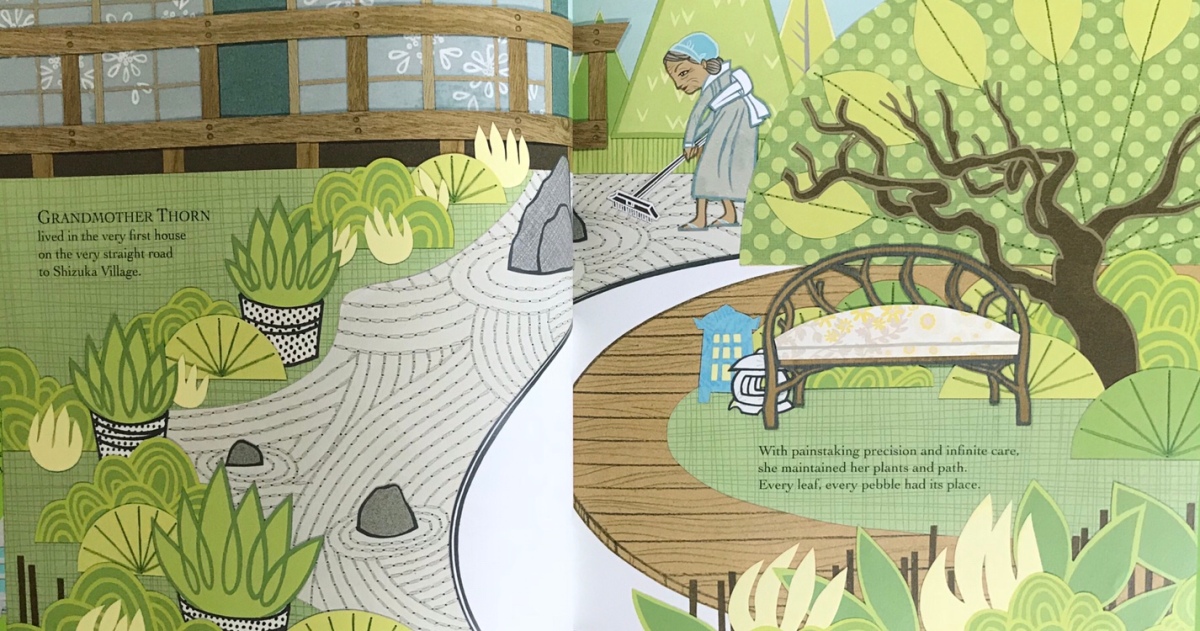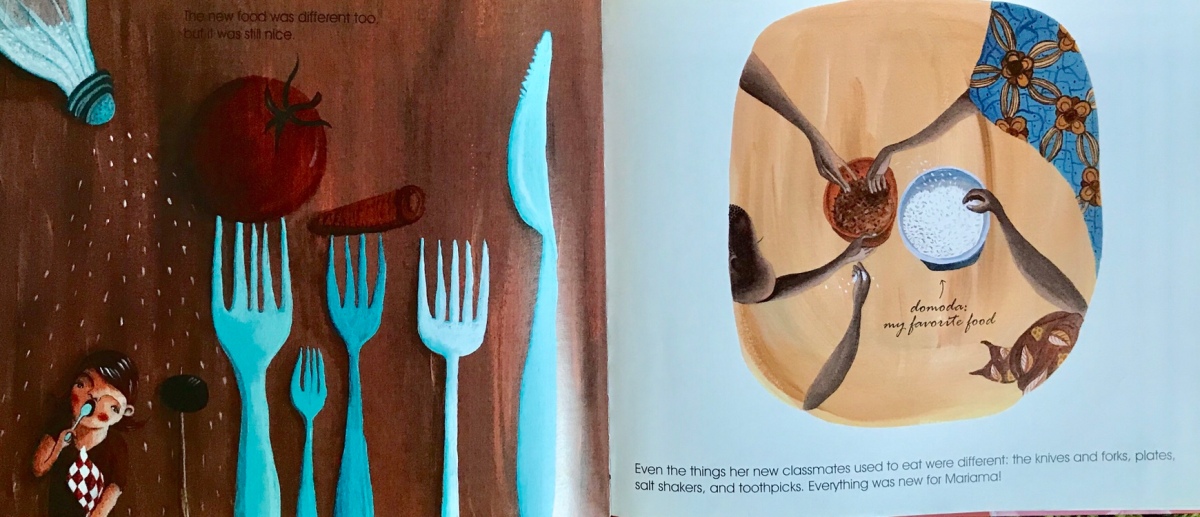Facing change is hard for everyone, adults and children alike. Here are 3 books to start conversations about our natural resistance to change and its unexpected benefits.

Monster’s New Undies by Samantha Berger, illustrated by Tad Carpenter
Monster’s New Undiesby Samantha Berger, illustrated by Tad Carpenter.
The familiar can be the most comfortable, even when it’s not—a fact of life known to all parents and captured perfectly in Monster’s New Undies. Refusing to relinquish ill-fitting, threadbare underwear until they literally fall apart, young Monster is the embodiment of resistance to change. Without any concrete rationale, he does NOT want new underwear… until he can have the same, exact pair as before, just a little better fitting. This is the perfect book for normalizing a child’s fear of change while teaching that not all changes are disruptive or unwelcome. The text is a spot-on rendition of toddler attitude while the illustrations capture the young monster’s emotional roller coaster—all making for a book young children (and parents) find highly relatable. Bonus: It’s a great potty training book for those looking to incentivize with the prospect of new underwear!

I am just FINE with no undies at all! Or the undies I HAVE… though they are a bit small. So WHAT if they’re old? So WHAT if they’re torn? Who cares the elastic’s completely outworn? Oh dear!

Um… Do you have a small towel? Or maybe a leaf? I thought that no undies would be a relief! Turns out it feels just a little bit c-c-cold. …And a little exposed… and A LOT to behold.

Those are too long! Those are too short! Those look like a diaper! Those look like a skort! Those are too boxy! Those are too tight! Those are too clingy! Those GLOW at night!

Hang on a second… What’s THAT on the rack? Behind all the rest, hung way in the back? They look just like mine but will fit like a glove. The moment I saw them, my tush fell in love!

We’ll take seven pairs! No, make it EIGHTEEN! They’re the most monstrous undies this bum’s ever seen!

I LOVE my new undies with all of my heart. I’ll wear them until they, TOO, fall apart!

Grandmother Thorn by Katey Howes, art by Rebecca Hahn
Grandmother Thornby Katey Howes, illustrated by Rebecca Hahn.
Grandmother Thorn has a beautiful garden, rigorously and precisely maintained. Highly invested in its perfection, she becomes overwhelmed by anger at the slightest change. When an unwelcome plant takes root and cannot be removed despite great effort, her emotional distress becomes physical illness. Ultimately, the troublesome plant bears delicious fruit and yields unexpected happiness. Grandmother Thorn teaches that resistance to change is natural, but in its extreme can lead to great suffering whereas embracing change can lead to unforeseen benefits. Well written with gorgeous illustrations printed on wonderfully textured paper, it is a joy to read and has quickly become a favorite in our house. Any child (or parent!) with a perfectionist streak would benefit from owning this lovely book and taking its wise message to heart.

Grandmother Thorn lived in the very first house on the very straight road to Shizuka Village. With painstaking precision and infinite care, she maintained her plants and path. Every leaf, every pebble had its place.

One steaming summer afternoon, Ojiisan sat, resting his sore joints. A Traveling merchant came to the village, bringing with him fruits that no one had ever seen. The moment Ojiisan tasted the deep-red berries with many seeds, he thought of his friend Grandmother Thorn and her love of sweets. “Kind traveler, I will give you an extra coin to deliver this last basket of berries to my friend. But I must warn you—only stand at the gate and call for her. If you disrupt her garden, you will regret it!”

The sound traveled straight to Grandmother Thorn’s ears, unleashing her anger. She sprang up and grabbed her rake, dashing toward the traveler and shouting wildly. The merchant sprinted away, dropping the basket of berries. Grandmother Thorn continued to yell as she gathered up the tumbling fruit. She did not notice one berry that rolled into a dimple in the ground.

A week later, Ojiisan spotted his friend crouched in the same place. “I must not have removed the entire root,” she said, digging up the offending vine. “I will certainly get it this time.” Each time Ojiisan visited, he found Grandmother Thorn more consumed by her battle with the stubborn sprout. He began to worry. “My friend, have you considered that everything on earth sooner or later meets its match?” “Excellent point, Ojiisan,” Grandmother Thorn answered. “Perhaps you might explain it to the plant.”

Ojiisan came to her one afternoon with a gift: a basket of the sweet, deep-red berries. “Where did you find these?” Grandmother Thorn asked. “I dreamed of them all winter long.” “Come with me,” Ojiison answered. “I have something to show you.”

Grandmother Thorn stared in silence. At last, a smile conquered her frown.

Mariama: Different But Just The Same by Jeronimo Cornelles, illustrated by Nivola Uya
Mariama: Different But Just the Sameby Jerónimo Cornelles, illustrated by Nívola Uyá.
Uprooted from her home in Africa and relocated to a place where the other children are “as white as the African moon,” Mariama faces change in almost every dimension of her life. Initially overwhelmed by the differences, she gradually adapts to her new home. Throughout the book she finds ways to stay connected to the past while embracing the present. And, most importantly, she learns that some things never change: children are children and we all look upon the same moon at night. This is a great book for any child facing a major change in life. Without minimizing the challenges, it emphasizes Mariama’s ability to adapt and find happiness in the face of change without forsaking her past. It’s a book about courage, resiliency, and the fact that all people are fundamentally the same—a message every child would benefit from hearing. Bonus: The illustrations make note of details such as Mariama’s home village, favorite food, and favorite game with a final spread dedicated to facts Mariama teaches her friends about Africa.

This is the story of a little girl named Mariama. One day, her parents told her that she was going to move to a country far, far away.

The new food was different too, but it was still nice. Even the things her new classmates used to eat were different: the knives and forks, plates, salt shakers, and toothpicks. Everything was new for Mariama!

The most amazing thing for Mariama was discovering that the only difference between her and Hugo and Paula was the color of their skin; and that although they had different customs, they were just the same in every other way.

Black or white, Mariama, Hugo, and Paula were all children. They were children who wanted to play and laugh…

Eventually, by working hard and with her friends’ help, Mariama learned to love and appreciate her new life. But even so, when night came, she felt very sad when she remembered the stars in the African sky and the stories her grandma, Isatu, used to tell her.

That was when Mariama remembered what her grandma had told her before she left: “Every night, wherever you are, when the mood rises, look up at it. I will be looking at it too. Then we will be together, and no land or sea will be able to keep us apart.”



[…] bio on the Storm site. Katey is the author of Grandmother Thorn, featured in my post about Facing Change earlier this week, and Magnolia Mudd and the Super Jumptastic Launcher Deluxe—watch for it in an […]
LikeLike
The Grandmother Thorn one sounds really great – I am a terrible perfectionist and resist change wherever possible. This book sounds like a really great way to tackle it and the illustrations are lovely! #blogcrush
LikeLiked by 1 person
These books are looking beautiful, and I love the theme of dealing with change! Great also to see so many excerpts so you really get a feel for each book. #BlogCrush
LikeLiked by 1 person
Thanks so much for reading and commenting! 🙂
LikeLiked by 1 person
[…] Blogcrush choice is Facing Change! by Read. Learn. […]
LikeLiked by 1 person
What fabulous books – I really enjoyed reading this post! I so wish I had grandchildren already – is it crazy to book mark this page ready..? x
LikeLiked by 1 person
I’m so glad you enjoyed it! 😊
LikeLike
What beautifully illustrated books with great messages.
#blogcrush
LikeLiked by 1 person
Thanks for reading! 😊
LikeLike
Some beautiful books there. Such gorgeous illustrations too. #BlogCrush
LikeLiked by 1 person
So glad you enjoyed them! ☺️
LikeLiked by 1 person
They look fantastic. My wife will love them too. She is a social worker in a hospice and ofen meets kids put through change in extremis!
LikeLiked by 1 person
Such an important and challenging job. I hope she finds the recommendations useful!
LikeLiked by 1 person
I love this post. Lots of useful books for kids to learn about change. Resilience is very important. #blogcrush
LikeLiked by 1 person
Thanks! ☺️
LikeLike
Another fab selection as usual! I’d love to show these to Dee! #BlogCrush
LikeLiked by 1 person
So glad you enjoyed them ☺️
LikeLike
Love fun educational books like this. The first made me giggle. #BlogCrush
LikeLiked by 1 person
It definitely has humor for parents in it! 😄
LikeLike
[…] Her book But the Bear Came Back was featured in my post on Facing Change. […]
LikeLike